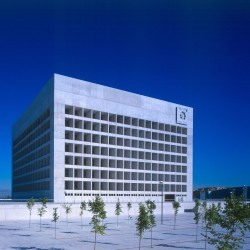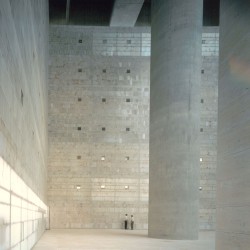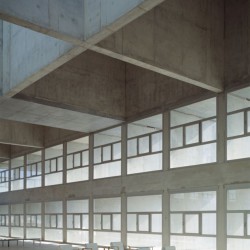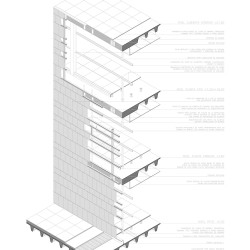A large cube is built on top of a podium flanked by two courtyards.
The parking areas, archives and Data Processing Center are accommodated in this podium. Offices are arranged inside the cube on seven floors around the central interior courtyard. The cube was constructed on a 3 x 3 x 3m grid of reinforced concrete that in the roof serves as a light-gathering mechanism, the central theme of this building. The two facades to the south operate as a “brise-soleil” and, filtering this powerful light, illuminate the areas of open offices. The two facades to the north, serving the individual offices, receive the homogeneous and continuous light of this orientation and are closed to the exterior by means of a stone and glass cladding.
The central interior courtyard, a true “impluvium of light”, gathers the solid sunlight through the skylights and reflecting it on the alabaster surfaces of the walls of the dihedron open to the south increases the illumination of the open offices to the dihedron facing north. The roof rests on four huge columns of exposed concrete. Functionally, the building is compact, flexible and simple.
In short, it is a concrete and stone box that traps the sunlight inside in order to serve the functions carried out within this “impluvium of light”.
_
Architect: Alberto Campo Baeza. Location: Granada, Spain. Client: Caja Granada General Bank. Competition: 1992. Project: 1998. Built: 2001. Area: 40.000sqm. Collaborators: Felipe Samarán Saló, Ignacio Aguirre López, Gonzalo Torcal Fdez-Corugedo, Raúl del Valle González, Emilio Delgado, Mª Concepción Pérez Gutiérrez, Tomás García Píriz, Pedro P. Arroyo, Patricia Esteve, Francisco Arévalo, Héctor Ruiz, Daniel Fraile, J. Miguel Castillo. Structure: Andrés Rubio Morán, Víctor Martínez Segovia. Engineering: Úrculo Ingenieros. Quantity surveyor: Juan Domingo Torres, Luis Olmedo García, Fernando Rodríguez. Contractor: OHL (Antonio Padilla). Project manager: LKS (Francisco Varela, Antonio Jiménez). Photographer: Hisao Suzuki, Fernando Alda, Duccio Malagamba, Alberto Piovano, Roland Halbe.
En este podio se resuelven aparcamientos, archivos y Centro de Proceso de Datos. En el cubo, alrededor del patio central, se organizan las oficinas en siete plantas. El cubo se construye con una trama de hormigón armado de 3 x 3 x 3 m que en la cubierta sirve de mecanismo para recoger la luz, tema central de este edificio. Las dos fachadas a sur funcionan a modo de «brise-soleil» e iluminan, matizando esa luz potente, las zonas de oficina abierta. Las dos fachadas a norte, sirviendo a las oficinas individuales, reciben la luz homogénea y continua propia de esa orientación y se cierran al exterior, mediante una plementería de piedra y vidrio. El patio central interior, verdadero «impluvium de luz», recoge la luz sólida del sol a través de los lucernarios y, reflejándola en los paramentos de alabastro del diedro abierto a sur, aumenta la iluminación de las oficinas abiertas al diedro orientado a norte. La cubierta se apoya en cuatro grandes columnas de hormigón visto. Funcionalmente el edificio es de una gran compacidad, flexibilidad y sencillez. En resumen, se trata de una caja de hormigón y piedra que atrapa la luz del sol en su interior para servir a las funciones que se desarrollan dentro de ese «impluvium de luz».





















